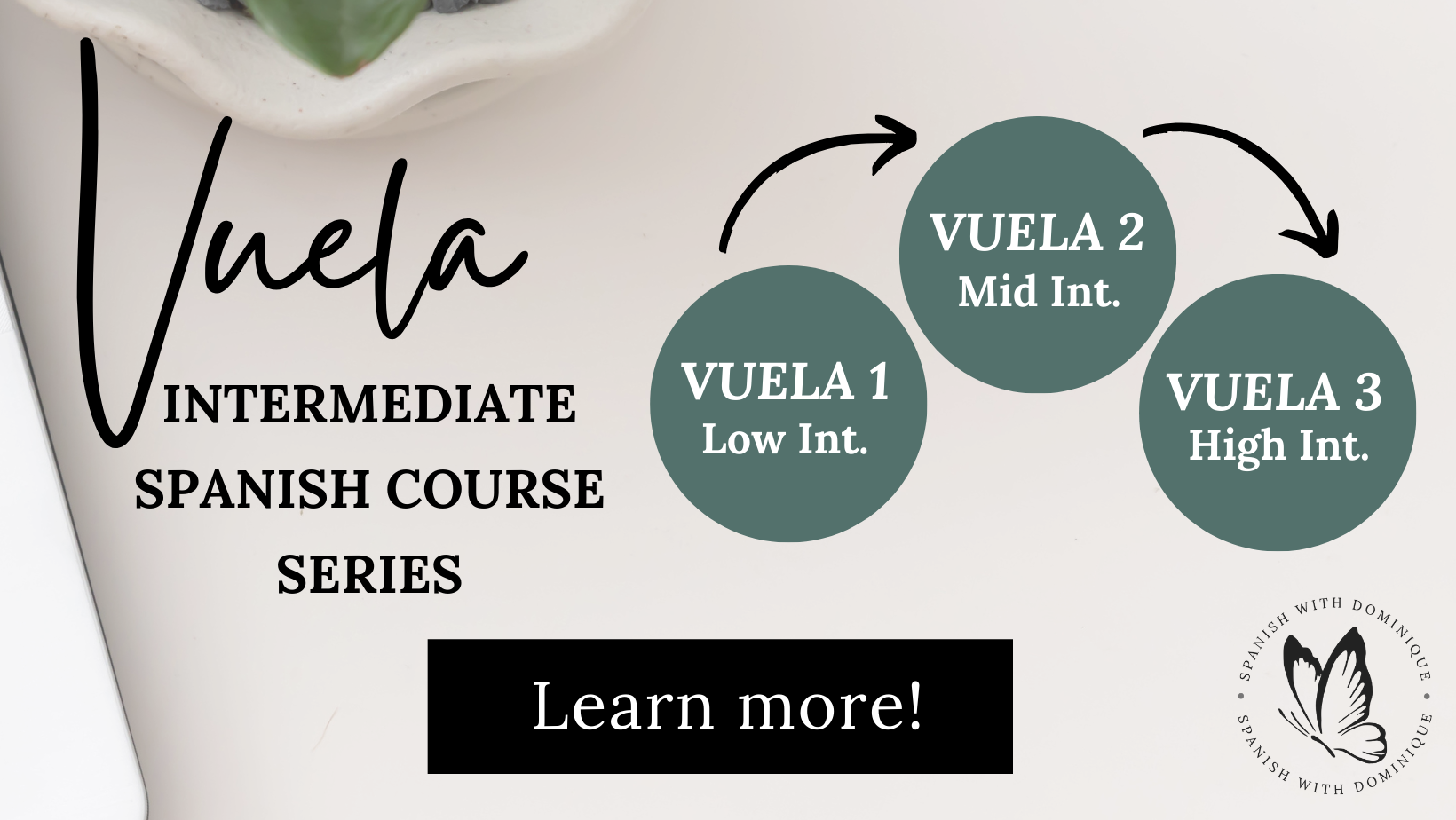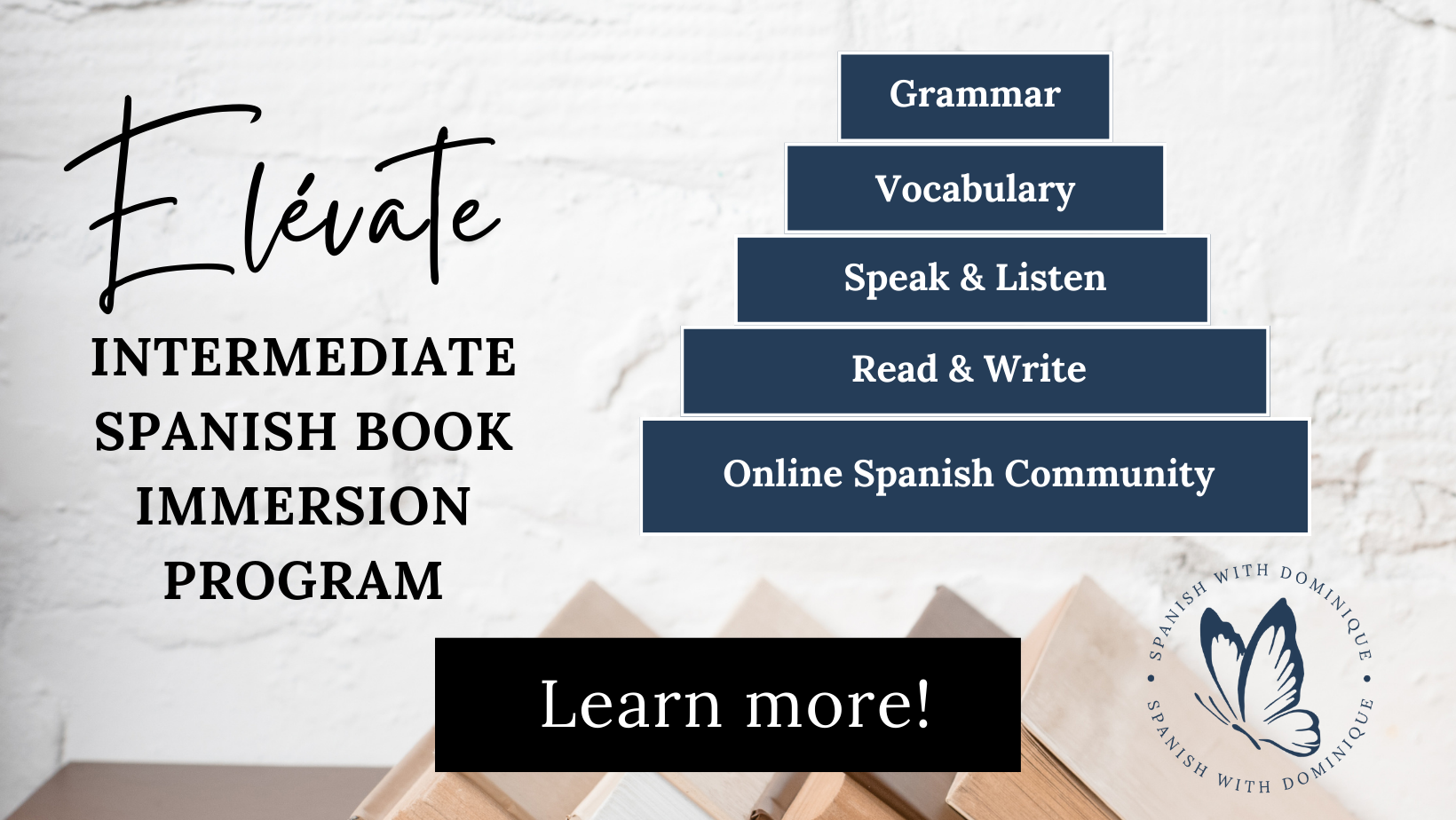How to Write in Spanish and Boost Your Fluency: 5 Ideas to Try Today
In this post: Learn how to write in Spanish and boost your conversational skills with 5 unique activities from journaling to song lyrics.
Are you wanting to improve your speaking fluency and add new words to your vocabulary at the intermediate level?
There’s a surprising way to do this without having to painfully sit through conversation practice sessions with your tutor, hoping you’ll “figure it out.”
You can start improving on your own by developing a writing habit early on.
You see, writing is your dress rehearsal for real-life conversations where you can prepare at your own pace.
It's a judgment-free zone where you’re free to play, make mistakes, and learn without the anxiety many of us feel “just” striking up conversations as adults.
I often tell the people I work with that writing is a stepping stone to fluency.
In today's post, you’ll discover why learning how to practice writing can help you finally speak Spanish like you’ve always wanted to.
You’ll also come away with five fun and surprising writing practices you can add to your Spanish routine today.
These are my favorites--as a learner and teacher.
While reading this post, consider these questions:
What does your current Spanish practice look like? Do you tend to practice listening, speaking, reading, or writing the most?
When you think of writing in Spanish, what comes to mind?
What typical conversations or situations are particularly difficult for you in Spanish?
How do I know writing in Spanish will help you with conversations?
I’ve used this technique myself!
As someone who learned Spanish as an adult, I learned this lesson through experience before I ever became a teacher.
In 2016 and 2017, I was living in Mexico City. I already had a pretty solid level of Spanish, having studied the language for about five years at that point.
But I wanted more.
I wanted to learn those regional nuances of Mexican Spanish to help me feel more at home in that tree-lined Condesa neighborhood where I lived, with its small coffee shops and quaint restaurants.
I wanted to speak like a local, authentically, like I belonged there.
The only problem?
The intermediate plateau was real for me --and those last few conversational skills I needed to feel a bit more like a local were not easy to reach.
But I'd always been an avid writer (blogging, journaling, writing articles). So, I decided to start journaling daily, in Spanish, about what I was experiencing on the streets of Mexico City.
If I went to the mercado and learned about a new type of local food, I would jot it down in my journal.
If I stepped out with native-speaking friends and heard a new expression or phrase, I would immediately reflect on it in my journal when I got home.
Some days, I would sit in Parque Mexico, and flip through the pages of my journal, reviewing all that new vocabulary (yeah, I was that crazy girl talking to herself at the park).
But I learned great new expressions I heard locals saying, like está cañón - an expression that means that something is difficult and requires effort.
And you know what? It paid off because, after a while, all that vocabulary started flowing out of my mouth as if I'd known it all my life. Sometimes, I'd even surprise myself!
It was a really natural process.
Writing allowed me to sit with the new language for a while. Play with it, experiment with it, until I was ready to take it out into the world.
At the time, I wasn’t a Spanish teacher yet, so I didn’t know why writing was so important--but I experienced as a learner how much it changed my conversational skills.
How exactly does writing in Spanish help you become more conversational?
Before you jump into how to practice writing, let’s talk about why writing helps you become more conversational.
Both writing and speaking are active language skills. You can’t just passively listen (or read) and understand--you have to actively produce something.
Learning to find your words when writing in Spanish will help you think on your feet and find your words when you speak.
Plus, adding more active practice, like writing, to your Spanish routine can reduce the time it takes you to become more conversational.
In fact, according to this 2015 study, it turns out that improving writing skills and speaking skills in language learning often go hand in hand.
Practice writing, and you’ll improve your Spanish vocabulary faster, develop ease in conversations and flexibility in speaking situations. You’ll also begin to grasp grammatical nuances.
And if you’re nervous speaking with native Spanish speakers--or struggling to dive into conversations? Learning to practice writing can be a game-changer.
Especially if the thought of making mistakes when you speak sounds embarrassing, writing your thoughts is like an extra chance to think before you speak.
Now that you’re armed with all the reasons why you should learn to incorporate writing into your Spanish routine, let’s take a look at some fun ways to get you started.
Let's start with something for even the super-busy Spanish learner: journaling!
Here’s something anyone can do, whether you’re retired with plenty of time on your hands or "forget-your-own-birthday" busy. If you’re that second one, yes, keep reading; you can do this, too.
A journal is your chance to slow down, wherever you are during the day.
You can do it in 10 minutes and combine this with a chance to breathe, think, and find your words.
Journaling lets you savor the moments you enjoyed during the day, connect with your feelings, and express yourself in Spanish.
You’ll also develop a highly personal vocabulary that goes with your life--whether you typically meet friends for coffee and a card game or drive your kids to soccer practice.
Also, taking a minute to slow down in your journal can help you remember interesting and important things--like how you’ve been meaning to invite an old friend over for dinner. Or that it’s your birthday.
To add a little variety to your Spanish journal, try any of the following:
Choose your own Spanish writing theme of the week.
Sometimes “just writing” about anything and everything can leave you stumped for ideas.
Or, you might want to be sure you remember new expressions for a particular situation and can use them actively. If so, try out a theme of the week.
If you want to get much more comfortable doing your shopping in Spanish, your topic could be about shopping and food.
Write down what happened on shopping trips, what you want to cook next, your shopping list, or a few things you heard on your last trip to the local Spanish-speaking grocery store.
Activate your Spanish vocabulary while you write--with vocabulary sprints.
Did you pick up a new word or phrase recently? Don't just write it down—practice writing sentences with it.
Keeping an ongoing record of expressions you want to learn and using them in an actual sentence is one of the best ways to improve your Spanish vocabulary quickly.
When you hear a fresh word or phrase, don't stop at merely jotting it down. Instead, dive into crafting sentences with it.
To really cement these new expressions, you can even keep a personal ‘dictionary’ of sorts where you write down and use new words--in any order that suits you.
Revisit what you wrote regularly. It’s a creative and engaging way to develop a richer and more nuanced vocabulary.
And don’t forget to take your Spanish writing practice out of your journal and into conversation.
For an extra challenge that will take you from writing to speaking, see if you can use any new word you wrote in your journal in a conversation or out loud in the next 24 hours.
You can also practice saying or recording any line from your journal until it rolls off your tongue. This way, you can use your new words and sentences in new situations.
Which brings me to my next go-to way to practice your writing.
If you want to be ready to improvise, write role-playing scripts in Spanish.
What would you like to be able to do in Spanish?
Order food at a restaurant? Book a hotel room?
Take a minute and imagine what that conversation would sound like.
What would you say? What might someone say back to you?
Practicing for new situations by writing role plays is something I did a lot when I wanted to push myself into a more advanced and culturally nuanced level of Spanish conversation.
Writing out conversations in the form of role plays gives you time to find a word or expression you don’t know.
After all, you could go straight to the bus station while in Mexico City and try to ask for the next bus headed for Oaxaca before you realize you have no idea how to go about it.
Or you could do a little research first for your role play so you can nail it with:
¿Cuál es la próxima salida para Oaxaca?
In the past, whenever I knew a particular conversation was going to be tricky for me, or I just wanted to remember it for another time, I would read my roleplay out loud a few times.
In short, if you’re wondering how to write in Spanish in a way that helps with real-life conversations, this is probably my favorite technique.
But it’s definitely not the only way to go from writing to speaking it.
Now for a little Spanish writing practice for the musically inclined: Jot down Spanish lyrics--and translate them.
Back before I knew Spanish, I already loved listening to salsa music artists (particularly Marc Anthony), even though I didn’t understand any of the words in his songs.
But, once I really got serious about learning Spanish, I acquired an incredible amount of vocabulary by taking pen to paper and translating the lyrics to my favorite salsa songs.
This is a great example of the power of mixing language learning with our interests.
And you know what? You can fall in love with Spanish lyrics, too. Here’s how to get started:
Begin by listening to your favorite Spanish song and writing down any phrases or words you do understand. (Don’t worry if you don’t understand it all!)
Now, do a search for the lyrics. You can practice writing the song down one line at a time if you like, or just check the actual song against what you thought you heard.
Then, translate the song into English. If you’re short on time, you can translate a few lines at a once.
You’ll discover a ton of new and exciting new expressions that are a lot of fun to use. It will also force you to look up new vocabulary words and review grammar structures.
Now that you have all the words and understand all the expressions, practice singing the lyrics out loud.
You can do this in the shower, while you walk your dog, or in the car - whenever the mood strikes you!
You’ll be amazed at how much this will help your Spanish pronunciation (trust me, I speak from experience!)
For more conversational writing practice, exchange WhatsApp messages with a native speaker.
These conversations can be in real-time or not. But they are bound to be authentic and will get you thinking on your feet and more comfortable in discussions through writing in Spanish.
Find a Spanish-speaking friend to communicate with on WhatsApp - this can also be your tutor.
This daily exchange will teach you more nuanced and authentic expressions--especially if you choose someone who speaks a dialect of Spanish you’re trying to focus on.
And, if you want to go from practicing your writing in Spanish to practicing your speaking, start sending voice messages instead.
WhatsApp makes it super easy. And the best part? You can listen to your audio before you press send and re-record if you want.
Are you a book lover? Then, jot down summaries as you read for more Spanish writing practice.
Reading chapter books in Spanish is a dream of many Spanish learners.
But as wonderful as reading is for your Spanish, it’s a passive activity.
This is why you’ll need to use an active language skill, like writing, to help you practice using what you’ve learned.
Writing short summaries about chapters in the books you’re currently reading is a great way to do that.
And that’s exactly why I incorporate this activity into my ELÉVATE Intermediate Spanish Book Immersion Program.
Being able to recall something that’s happened in a story in your own words is a powerful skill to develop. It helps you become a better storyteller when it’s time to start speaking.
Writing summaries also helps you use new vocabulary you discover as you read. And it gets you ready to join conversations about your book.
Ready to go from practicing writing about your book in Spanish to speaking about it? Join a Spanish-speaking book club, find a reading buddy, or try out a reading program in Spanish.
Takeaways:
So often, in our quest to become conversational in Spanish, we skip writing altogether.
But writing is not just some academic pursuit you only need in school--it’s a genuine stepping stone to being able to join real-life conversations with ease and authenticity.
Practice your writing in Spanish, and you’ll be practicing active language production, finding your words, using and activating incredible new expressions, and being spontaneous.
For the busiest among us, writing offers the chance to practice anywhere, anytime.
Whether you're jotting down daily journal entries, translating song lyrics, or practicing the conversation you’ll have with the guide when you visit the Tikal ruins in Guatemala.
Committing to your daily Spanish writing practice can help you respond to your new local friend’s hilarious anecdotes with more natural-sounding expressions like, “No manches!” or “Neta?!” while visiting Mexico City.
Every sentence you write in Spanish brings you one step closer to being able to speak Spanish in a way that’s effortless and authentic enough to make you feel like part of the conversation--and the culture.







